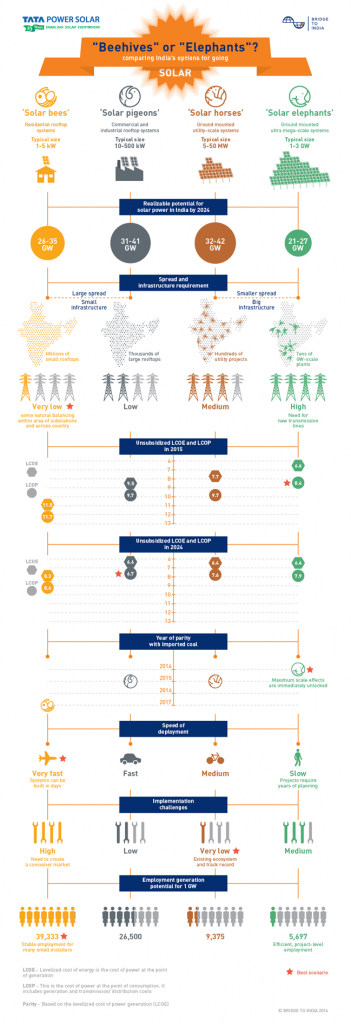India has the potential to grow its solar PV capacity by more than 140GW over the next decade if it chooses the right policy path, a new report has found.
The report – How should India drive its solar transformation? Beehives or Elephants, by Tata Power Solar and cleantech experts Bridge to India – argues that solar could revolutionise India’s energy mix, as long as decision-makers followed the best possible roadmap.
The researchers compared four different scenarios, each with a different solar focus – residential rooftops (solar bees); large rooftops (solar pigeons); utility-scale (solar horses); and ultra-mega projects (solar elephants) – evaluating their potential speed of deployment, implementation challenges and job creation potential.
“The realizable potential for solar power generation in India is between 110GW to 145GW across (all four) different types of systems,” said Bridge to India founder and director Tobias Engelmeier. “The four scenarios together could easily create over 675,000 solar jobs in India in the next 10 years.
“But the real issue, is to choose the best way for India to go solar that entails a fair choice between millions of small systems (“bees”) on one end of a spectrum, and a few very large systems (“elephants”) on the other; the former creating a consumer market and the latter an infrastructure market,” Engelmeier said.
Longer-term, the report suggests that large rooftop solar systems – the pigeons – will prove the cheapest option, achieving an LCOE of $US0.10/kWh and an LCOP of just $US0.11/kWh by 2024.
According to PV Magazine, the analysts compared each scenario in terms of landed cost of power (LCOP) – the cost to the consumer at the point of consumption – and levelised cost of energy (LCOE).
While LCOE is the more traditional gauge of renewables generation costs, analysts at Bridge to India and Tata argue that LCOP, which can be as much as 30 per cent higher than LCOE, should become the new economic metric for measuring India’s solar potential.
The report calculates that the LCOE for ultra-mega plants in India is 6.6 rupees per kWh ($US0.10c/kWh), with LCOP at 8.4R/kWh ($US0.14c) – already comparable to imported coal (Bloomberg New Energy Finance has predicted that solar PV in India will best both gas and coal on costs by 2020).
And with the price of coal expected to increase, the other three scenarios would also be expected to reach parity during that time.
Top image via Tata Power Solar / Bridge to India
© 2014 Solar Choice Pty Ltd
